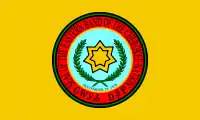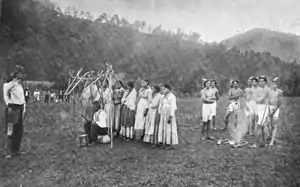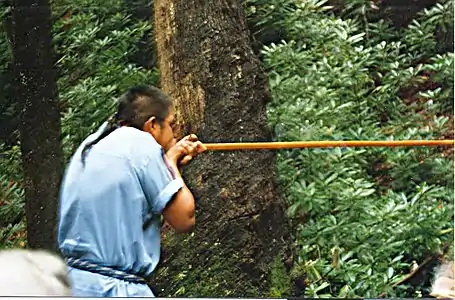Eastern Band of Cherokee Indians
The Eastern Band of Cherokee Indians (EBCI), (Cherokee: ᏣᎳᎩᏱ ᏕᏣᏓᏂᎸᎩ, Tsalagiyi Detsadanilvgi) is a federally recognized Indian Tribe based in Western North Carolina in the United States. They are descended from the small group of 800-1000 Cherokee who remained in the Eastern United States after the US military, under the Indian Removal Act, moved the other 15,000 Cherokee to west of the Mississippi River in the late 1830s, to Indian Territory. Those Cherokee remaining in the East were to give up tribal Cherokee citizenship and to assimilate. They became US citizens.[1]
 | |
| Total population | |
|---|---|
| 16,000+ | |
| Regions with significant populations | |
| United States (North Carolina) | |
| Languages | |
| English, Cherokee | |
| Religion | |
| Christianity (mostly Protestant), traditional tribal religion | |
| Related ethnic groups | |
| Cherokee Nation, United Keetoowah Band of Cherokee Indians |
The history of the Eastern Band closely follows that of the Qualla Boundary, a land trust made up of an area of their original territory. When they reorganized as a tribe, they had to buy back the land from the US government. The EBCI also own, hold, or maintain additional lands in the vicinity, and as far away as 100 miles (160 km) from the Qualla Boundary. The Eastern Band of Cherokee Indians are primarily the descendants of those persons listed on the 1925 Baker Rolls of Cherokee Indians. They gained federal recognition as a tribe in the 20th century. The Qualla Boundary is not a reservation per se because the tribe owns the land outright.
The Eastern Band of Cherokee Indians is one of three federally recognized Cherokee tribes, the others being the Cherokee Nation and the United Keetoowah Band of Cherokee Indians, both based in Oklahoma. The EBCI headquarters is in the namesake town of Cherokee, North Carolina in the Qualla Boundary, south of the Great Smoky Mountains National Park.
History, language and religion

The Eastern Band members are descended primarily from about 800 Cherokee living along the remote Oconaluftee River who were not forcibly subjected to the Trail of Tears to Indian Territory (now Oklahoma). Principal Chief Yonaguska, with the help of his adopted European-American son, William Holland Thomas, managed to avoid removal. The Eastern Band of Cherokee Indians have maintained many traditional tribal practices. Many prominent Cherokee historians are affiliated with, or are members of the Eastern Band.
Tsali (pronounced [ˈtsali]) opposed the removal. He remained in the traditional Cherokee lands with a small group who resisted the U.S. Army and tried to thwart the removal. Tsali was eventually captured. He was executed by the United States in exchange for the lives of the small band he protected. They were allowed to remain in the Cherokee homeland, with the condition that they give up Cherokee tribal citizenship and assimilate as US citizens, and thus state citizens as well.
Their descendants reorganized in the 20th century and gained federal recognition as a tribe known as the Eastern Band of Cherokee Indians (named in reference to the majority of the tribe, who moved west to Indian Territory in 1839.) They bought back land in what is known as Qualla Boundary, part of their traditional territory that had been ceded in the 19th century to the US government by other Cherokee leaders prior to removal.
Their Museum of the Cherokee Indian in Cherokee, North Carolina exhibits an extensive collection of artifacts and items of historical and cultural interest, from the Woodland and early South Appalachian Mississippian culture periods, of which there are remains such as numerous [earthwork [platform mounds]] in the area, to the Cherokee culture developed by the 16th and 17th centuries by the Cherokee. . They are an Iroquoian-speaking people, related by language to those nations in the Iroquois Confederacy and other Iroquoian-speaking groups traditionally occupying territory around the Great Lakes.
The Qualla Arts and Crafts Mutual, located near the museum, sells traditional crafts made by its members. Founded in 1946, the Qualla Arts and Crafts Mutual is the country's oldest and foremost Native American crafts cooperative.[2]
Contemporary language and religion

More than two dozen Christian churches of various denominations are located within the Qualla Boundary. Many of the traditional religious practices of the Eastern Band have, over time, blended with new age views and customs according to Cherokee traditionalists. They have diverged as the result of cultural isolation of the various factions of Cherokee society. Many traditional dances and ceremonies are still practiced by the Eastern Band.
The Eastern Band has begun a language immersion program requiring all graduating high school seniors to speak the tribal language beginning 2007. Of the total population in the Qualla Boundary, there are approximately 900 speakers, 72% of whom are over the age of 50.[3]
Eastern Cherokee Indian Land Trust (Qualla Boundary)

The Eastern Cherokee Indian Nation Land, officially known as the Qualla Boundary, is located at 35°28′43″N 83°16′20″W in western North Carolina, just south of Great Smoky Mountains National Park. The main part of the reserve lies in eastern Swain County and northern Jackson County, but smaller non-contiguous sections are located to the southwest in Cherokee (Cheoah community) and Graham counties (Snowbird community in the latter). A small part of the main reservation extends eastward into Haywood County. The total land area of these parts is 213.934 km² (82.600 sq mi), with a 2000 census resident population of 8,092 persons.[4]
The Qualla Boundary is not strictly a reservation, but rather a "land trust" supervised by the United States Bureau of Indian Affairs. The land is a fragment of the extensive original homeland of the Cherokee Nation, which once stretched from western Virginia, North and South Carolina, and west to present-day southeastern Tennessee and northeastern Alabama. In the 19th century, the people had to purchase their land to regain it after it was taken over by the US government through treaty cessions, which had all been negotiated by a small percentage of assimilated Cherokees.
Today the tribe earns most of its revenue from a combination of Federal/State funds, tourism, and the Harrah's Cherokee Casino, established in the early 1990s. The gaming revenue is directed at economic development, as well as tribal welfare and support of cultural initiatives, such as the language immersion program and development of historic preservation programs.
Acquisition of sacred mounds and towns
Since the late 20th century, the tribe has acquired such sacred sites as Nikwasi Mound (2019, in Franklin, North Carolina) and, downriver, Cowee (2007) (with 70 acres) and Kituwah (1996) mounds, each along the Little Tennessee River. Each is estimated to have been built more than 1,000 years ago. The EBCI also acquired the Tallulah Mound in Robbinsville, North Carolina in 1996.[5]
In 2020 Mainspring Conservation Trust acquired 40 acres that include the Watauga Mound and part of the ancient Watauga Town site, to conserve on behalf of the EBCI. The property is located between Nikwasi upstream and Cowee downstream.[6]
The EBCI is working with local non-profits, such as Mainspring Conservation Trust, Western Carolina University, and local governments to develop the "Nikwasi Trail", highlighting a route along the Little Tennessee River. This is formally known as the Nikwasi-Cherokee Cultural and Heritage Corridor, beginning in Macon County, North Carolina, where the river enters from Georgia.[7] In 2018 partner groups installed a viewing overlook with interpretive panels across the river from the Cowee mound site. This is the second sacred site on this corridor going north from Franklin.[7] More highlighting and interpretation of such sites is planned, in connection with related activities along this route.
Since 2011 the EBCI have also been collaborating with regional universities, the Cherokee Preservation Foundation, and the Duke Energy Foundation on what is called the "Western North Carolina Mounds and Towns Project." As part of this, Western Carolina University, the Coweeta Long Term Ecological Research Program at the University of Georgia, and the Tribal Historic Preservation Office of the EBCI have conducted outreach with tribal members, in what is described as indigenous archeology.[8] The data gathered integrates tribal knowledge, as well as information from GIS and non-invasive technologies, excavations, archeology, and anthropology. This has enabled the tribe to have a better record of mounds, with location data and chronological data for its use. Because such mounds were subject to looting in the past, the tribe is keeping the locations of most mounds secret in order to preserve them.[5]
Recreational tourism
Tourism in the area also offers many campgrounds, trails and river adventures, mountain biking, fishing, golfing, spas, Great Smoky Mountains National Park, the Blue Ridge Parkway, Unto These Hills Outdoor Historical Drama, Oconaluftee Indian Village, Cherokee Botanical Garden and Nature Trail, the award-winning Museum of the Cherokee Indian, zoos, restaurants, and a collection of galleries and shops representing fine traditional artists, such as Qualla Arts and Crafts Mutual.
Gaming relations with North Carolina
In 1988, the United States Congress passed the Indian Gaming Regulatory Act (IGRA), which allowed federally recognized tribes to establish casinos on tribal property. Under the act, tribes are limited to offer casino games that correspond to the existing level of gaming allowed under state law. North Carolina was unique in permitting the Cherokee to establish a casino offering Class III gaming in 1994, well before the state allowed a lottery. The typical pattern has been for states to offer a lottery, followed by an agreement between the state and the Indian tribe to allow establishment of a casino or other form of gaming operation.[9]
The first major casino in North Carolina, Harrah's Cherokee (in partnership with Caesars Entertainment), was opened on Qualla Boundary on November 13, 1997.[10] The casino was the result of nearly ten years of negotiations among tribal, state, and federal officials. Principal Chief Jonathan "Ed" Taylor, North Carolina Lead Liaison and Chief Negotiator David T. McCoy, and Governor Jim Hunt had developed a plan for a casino that would meet state laws, and satisfy local and tribal concerns.[9] It opened during the tenure of Principal Chief Joyce Dugan (1995-1999).
Tribal leaders wanted to be able to offer more than bingo and other Class I forms of gambling, to attract larger crowds and generate greater revenue. The tribe had previously opened a small casino offering forms of video poker and electronic bingo. This had been challenged by the Asheville, North Carolina U.S Attorney on the grounds that the tribe was offering a form of gambling that was not legal elsewhere in North Carolina. The tribe wanted to ensure agreements with the state to prevent such problems.[9]
Since North Carolina established a state lottery in August 2005, Harrah’s Cherokee casino has been permitted to extend its offered games to include Class II and III gambling. As thousands of people visit Harrah’s each year and the casino’s popularity continues to increase, the economic benefits of the casino are being realized. Annually, at least $5 million of casino profits is given to the Cherokee Preservation Fund; this institution pays for projects that promote non-gambling economic development, protect the environment, and preserve Cherokee heritage and culture.[11] Another portion of casino profits goes to improving tribal health-care, education, housing, etc. Part of the revenue goes to the state of North Carolina, as provided by the agreement drafted by Taylor and Hunt.[9]
In 1996, the first amendment to the compact was entered into the Federal Register, establishing the appointments of the Gaming Commission, staggered five-year terms for commissioners, and the ability to hire independent legal counsel upon Tribe approval.[12] In 2001, the second amendment to the compact was entered: it raised the gambling age from 18 to 21, affected the qualifications and appointments to the Gambling Commission between the Tribe and the North Carolina Governor, created the Cherokee Preservation Foundation, and clarified games, prizes and gifts awarded.[13] In 2002, an agreement of authorization was reached that allowed the Tribe to hold electronic bingo and raffle games.[14]
In 2011, Governor Bev Perdue and Principal Chief Michell Hicks came to an agreement on a new 30-year gaming compact. The agreement allowed live table games and grants the Tribe sole rights to provide those games west of Interstate 26. Based on this grant of exclusivity, the Tribe had agreed to a revenue-sharing agreement with the State, with funds to be used by the state only for public education purposes.[15][16]
On September 28, 2015, the Tribe opened their second casino, Harrah's Cherokee Valley River, in Murphy, North Carolina.[17] On July 26, 2019, Governor Roy Cooper signed Senate Bill 154 that permitted wagering on sports and horse racing on tribal lands, after the state legalized sports betting in other venues.[18]
Notable members
- Goingback Chiltoskey (1907–2000), woodcarver and educator
- Amanda Crowe (1928–2004), sculptor and educator
- Joyce Dugan (c.1952 - ), educator and Principal Chief, first woman elected to this position
- Charles George (1932–1952), Medal of Honor recipient[19]
- Shan Goshorn (1957–2018), visual artist
- Myrtle Driver Johnson (1944–), Beloved Woman and translator
- Nimrod Jarrett Smith (1837–1893), Principal Chief
- Lottie Queen Stamper (1907–1987), basket maker and educator
- Amanda Swimmer (1921–2018), potter, given the title of Beloved Woman[20]
- William Holland Thomas (1805–1893), Principal Chief
- Jeremiah "Jerry" Wolfe (1924–2018), Cherokee stone carver, stickball caller, storyteller, veteran, and Beloved Man
See also
- Stickball (Native American)
- Cherokee Preservation Foundation
- Harrah's Cherokee
- New Kituwah Academy
Notes
- "Eastern Band of Cherokee Indians." Archived January 19, 2012, at the Wayback Machine (retrieved July 25, 2011)
- Qualla Arts and Crafts Mutual, Inc., Smoky Mountain Host of North Carolina (retrieved July 1, 2014)
- Comprehensive Cherokee Language Survey, EBCI Dept. of Cultural Resources. Cherokee, NC. 2005.
- United States Census Bureau, Eastern Cherokee Reservation, North Carolina
- Stone, Jessi (August 3, 2016). "Protecting the past: Mounds hold key to understanding Cherokee history". Smoky Mountain News. Retrieved December 19, 2020.
- "Mainspring conserves Historic Cherokee Town". Cherokee One Feather. Mainspring Conservation Trust press release. July 14, 2020. Retrieved November 18, 2020.
- McGoun, Bill (August 2, 2019). "Opinion: Nikwasi-Cherokee Corridor reminds us of mountains' true history". Citizen Times. Retrieved December 17, 2020.
- Steere, Benjamin A. (2015). "REVISITING PLATFORM MOUNDS AND TOWNHOUSES IN THE CHEROKEE HEARTLAND: A COLLABORATIVE APPROACH" (PDF). Southeastern Archaeology. 34 (3): 196–219. Retrieved December 15, 2020.
- Sedgwick, Jessica. "This Month in North Carolina History: November 1997 – Cherokee Casino Opens." Archived October 26, 2008, at the Wayback Machine Southern Historical Collection, Wilson Library. University of North Carolina at Chapel Hill. November 1997 (retrieved December 18, 2009)
- North Carolina Education Lottery. "About Us, Introduction and Timeline." Cited October 1, 2008.
- "Cherokee casino should be granted the option other tribal casinos enjoy," Asheville Citizen-Times, Asheville, North Carolina. December 12, 2005.
- "Amendment to Tribal-State Compact Between the Eastern Band of Cherokee Indians and the State of North Carolina" (PDF). Washington, DC: Bureau of Indian Affairs. July 9, 1996. Retrieved July 18, 2020.
- "Second Amendment to Tribal-State Compact between the Eastern Band of Cherokee Indians and the State of North Carolina" (PDF). Washington, DC: Bureau of Indian Affairs. January 17, 2001. Retrieved July 18, 2020.
- "Agreement and Authorization under Section 4(B) of the Tribal-State Compact between the Eastern Band of Cherokee Indians and the State of North Carolina" (PDF). Washington, DC: Bureau of Indian Affairs. January 17, 2001. Retrieved July 18, 2020.
- McKie, Scott (November 30, 2011). "Tribe, State reach compact agreement". Cherokee One Feather. Cherokee, NC. Retrieved July 18, 2020.
- "First Amended & Restated Tribal-State Compact between the Eastern Band of Cherokee Indians and the State of North Carolina" (PDF). Washington, DC: Bureau of Indian Affairs. August 13, 2012. Retrieved July 18, 2020.
- Omarzu, Tim (August 23, 2015). "New Cherokee casino opening just two hours away from Chattanooga area". Chattanooga Times Free Press. Retrieved July 18, 2020.
- Ruggieri, Melissa (August 23, 2015). "Harrah's Cherokee casinos to open sportsbooks after sports betting legalized in North Carolina". The Atlanta Journal-Constitution. Retrieved July 18, 2020.
- "Private First Class George", Congressional Medal of Honor Society (CMHOS.org)(retrieved April 7, 2011)
- Kays, Holly. "Amanda Swimmer named Beloved Woman". Smoky Mountain News. Retrieved April 23, 2018.
References
- Finger, John R. Cherokee Americans: The Eastern Band of Cherokees in the 20th Century. Lincoln: University of Nebraska Press, 1993. ISBN 0-8032-6879-3
External links
- Official Government Website of the Eastern Band of Cherokee Indians
- Museum of the Cherokee Indian
- Cherokee Preservation Foundation
- Qualla Arts and Crafts -- an artists' cooperative founded in 1946, focused on preserving and promoting the traditional arts and crafts of the Eastern Band of Cherokee.